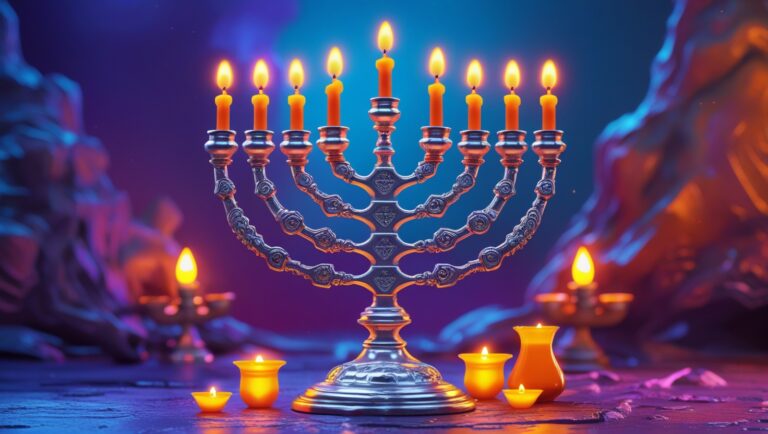“The Erev Rav delay the redemption much more than all the nations of the world”
The above quote is from the Sefer HaZohar, section Ra’aya Me’heimna. It’s a chilling testament that there’s a sect of evil that is actively doing everything in their power to prevent the Geulah (final redemption). They are organized, highly intelligent and create chaos from behind the veil of our enlightened modern life.
Who or what is the Erev Rav?
The Erev Rav first appears in the Torah during the Exodus:
“The Children of Israel traveled from Ramses towards Succot. There were about 600,000 adult males on foot, besides the children. The Erev Rav also went up with them.”
(Shemot 12:37–38)
So, who were they? According to the Zohar, the Erev Rav were not simply a diverse group of converts or followers. Instead, they were the sorcerers and magicians of Egypt, individuals steeped in spiritual opposition to the Creator. Despite Hashem’s warning to exclude them, Moshe allowed them to join the Israelites, believing their conversion to the Torah was genuine.
As the Zohar HaKadosh explains:
“The ‘mixed multitude’ (Erev Rav) consisted entirely of one people…all the sorcerers of Egypt and all its magicians… When they saw the signs and wonders which Moshe wrought in Egypt, they came to Moshe to be converted. Said the Holy One to Moshe: ‘Do not receive them.’ But Moshe replied, ‘Now that they have seen Your power, they desire to accept our Faith.’ And Moshe accepted them.” (Ki Tissa 191a)
This fateful decision introduced a deeply complex element into the journey of redemption, one that continues to resonate today. And we are still trying to rectify for their troubles.
The Origins of the Erev Rav
The roots of the Erev Rav extend deep into the spiritual and metaphysical history of Adam HaRishon, tracing back to the earliest chapters of creation. According to the teachings of the Sages and the Arizal, their origins are intricately linked to the forces unleashed during his period of separation from Chava.
The Talmud (Eruvin 18b) states:
“All the years Adam was in excommunication, he fathered Ruchin, Shiddin, and Lillin [demons and evil spirits]… Adam lived 130 years and fathered a son in his likeness and image (Bereishis 5:3), implying that until then, he fathered beings unlike his form.”
During this time, Adam, in his profound repentance, wore a belt of date branches, leading to spilling of seed and the unintended creation of these entities. These souls, though originating from a holy root, became intertwined with the forces of impurity (Klipot).
The Arizal’s Teachings on the Erev Rav
The Arizal expands on this concept, revealing a fascinating dimension:
All the Shedin and Ruchin created during Adam’s 130 years were elevated and holy souls from the level of Da’as (knowledge)… but they became mixed with the Klipot, requiring many gilgulim (reincarnations) for rectification.”
This spiritual entanglement delayed the formation of the Jewish nation, as these souls required refinement over generations. Only in the time of Yaakov Avinu, who rectified the spiritual damage of Adam, did the process of Tikun begin in earnest. The Jewish people, born within the spiritual impurity of Egypt, were described as a “nation within a nation” (Devarim 4:34), extracted and purified through the Exodus.
The Generational Reincarnations
The Arizal details the journey of these souls through successive generations of gilgulim:
- The Generation of the Flood – Described in Bereishis 6:7 as “the Man (HaAdam)” who caused God to regret their creation. These souls represented the fallen seed of Adam.
- The Generation of the Dispersion – Builders of the Tower of Babel, referred to as “sons of the Man (HaAdam)” (Bereishis 11:5).
- The People of Sodom – Their sins reflected the “evil” nature of the destroyed seed of Adam (Bereishis 13:13).
- The Generation of Egypt – Reborn as the Israelites in the Egyptian exile, these souls began their final Tikun through the redemption process.
The journey of the Erev Rav is thus not merely a historical narrative but a profound spiritual saga, embodying the ongoing struggle to elevate the sparks (Nitzotzot) of Kedusha (Holiness) from the depths of impurity.
The Erev Rav and the 130-Year Connection
The journey of the Erev Rav is deeply tied to a recurring motif of 130 years, symbolizing the spiritual labor needed to rectify the souls of this group. As explained by the Sages and the Arizal, these souls were not completely refined in their earlier incarnations and thus found themselves in Egypt during the time of Yosef and Ya’akov.
The souls that achieved complete rectification became part of the Children of Israel and descended to Egypt with Ya’akov. However, those still in need of refinement remained as Egyptians. Yosef, acting on Divine guidance, circumcised many of these souls, as referenced in the verse:
“Go to Yosef and do whatever he tells you to do” (Bereishis 41:55).
Furthermore, Bereishis Rabbah (84:4) mentions that Ya’akov himself converted many Egyptians during his time. These converts lived apart from mainstream Egyptian society, visibly distinct from the rest of the population. Pharaoh, observing this, declared:
“The people, the Children of Israel are more numerous and greater than us” (Shemos 1:8).
This statement referred to the Erev Rav, who had doubled the size of the Jewish population.
Moshe’s Connection to the Erev Rav
The Arizal reveals that the Erev Rav were sparks of Moshe Rabbeinu’s soul, which is why Moshe was so committed to their rectification (Aitz Chaim, Sha’ar 32, Perek 2). This connection also explains why Moshe was born to Yocheved when she was 130 years old—a clear parallel to the 130 years during which Adam HaRishon’s separated state led to the creation of these souls.
Even the Torah hints at this relationship. During the dedication of the Mishkan—a rectification for the sin of the Golden Calf instigated by the Erev Rav—each tribal prince brought a silver dish weighing 130 shekels:
“Nachshon, the son of Aminadav of the tribe of Yehudah, offered on the first day. He offered one silver dish, 130 shekels in weight (Bamidbar 7:12–13).”
The word for “weight” (mishkelah) can be broken into two parts: mem-shin-heh (Moshe) and kuf-lamed (130), emphasizing Moshe’s role in the spiritual rectification of these souls.
Ya’akov’s 130-Year Milestone
Divine Providence further ties this theme to Ya’akov Avinu, who entered Egypt at the age of 130 (Bereishis 47:9). Ya’akov, like Yosef, understood that Tikun Olam—the rectification of the world—required elevating these souls from impurity to holiness. His arrival at precisely this age was no coincidence but a Heavenly signal of his mission to assist in this monumental task.
The Mishkan as a Tikun
The Mishkan itself, constructed to rectify the sin of the Golden Calf, symbolizes this ongoing spiritual labor. The silver dishes, Moshe’s connection to the Erev Rav, and the dedication rituals all point to the enduring effort to transform these wayward sparks into vessels of holiness.
The recurring motif of 130 years serves as a profound reminder of the enduring effort required to rectify the fallen sparks of Adam HaRishon, a process that spans generations and remains central to the ultimate redemption.
The Erev Rav: The Hidden and Most Challenging Enemy
The concept of the Erev Rav (Mixed Multitude) represents one of the deepest spiritual and existential challenges facing the Jewish people, as elaborated upon by the Vilna Gaon, the Divrei Chaim, and other great thinkers. Far from being an external enemy, the Erev Rav is an internal force, cloaked in religious garb, making it all the more insidious and difficult to confront.
The Greatest Spiritual Battle
As the Kol HaTor explains, the primary mission of this generation is to “break and remove the strength of the Erev Rav.” This force is described as the k’lipah (negative spiritual shell) of Armelius the Evil, working to separate the two moshiachs—Moshiach ben Yosef and Moshiach ben David. The nature of the Erev Rav’s power lies in deception, employing subterfuge to undermine Israel’s spiritual mission:
“The war against the Erev Rav is the most difficult and bitterest of all” (Kol HaTor, Chapter 2).
The Leaders in Exile
The Vilna Gaon underscores the unique position of the Erev Rav as leaders within the Jewish community during the exile. The term rav denotes their elevated status, suggesting that they often occupy positions of influence, authority, and learning. This aligns with the Divrei Chaim’s chilling prediction:
“Before the arrival of Moshiach, most of the rabbis will be from the Erev Rav, because Israel in themselves are holy, but the Erev Rav only work for their own benefit . . . wanting to rule over the public . . .”
This teaching is a profound warning: not all who appear as spiritual leaders or scholars are aligned with G-d’s will. Their motivations, often rooted in personal gain, make them dangerous agents of spiritual destruction.
A Deceptive Piety
Unlike secular forces that are openly antagonistic, the Erev Rav appears outwardly religious. They fulfill the mitzvos externally and may even be admired for their piety and knowledge. However, their actions lack the purity of intent (lishmah), and their true nature is revealed over time. As the Divrei Chaim emphasizes:
“One should only join with those who truly serve G-d and sacrifice themselves to Him, but not in order to receive any benefit.”
It is not the deeds themselves but the motivation behind them that distinguishes the holy from the profane.
The Zohar and the Vilna Gaon
The Zohar and the Vilna Gaon bring even more clarity to this phenomenon, linking the Erev Rav to the 974 generations that preceded Creation. These souls, as described in Sifra D’Tzniusa, are spiritually incomplete and interwoven with the Jewish people as a test and refinement.
“In Sifra D’Tzniusa, Chapter 1, the GR”A (Vilna Gaon) . . . combines the 974 Generations together with the Erev Rav, saying that 974 Generations are the Erev Rav.”
This connection emphasizes the deep, almost primordial role of the Erev Rav in the spiritual struggle of the Jewish people. They are not merely a historical group but an enduring spiritual reality that requires vigilance and discernment.
Identifying the Erev Rav
The challenge lies in recognizing the Erev Rav, as their outward observance often masks their inner corruption. Yet their ultimate aim—to subvert the Jewish mission and separate Israel from its divine purpose—betrays their essence. As the Kol HaTor teaches, the battle against the Erev Rav is not only physical or ideological but deeply spiritual, demanding clarity of purpose and unwavering commitment to G-d.
The Erev Rav represents the most insidious threat to Jewish continuity, not because of their outward opposition but because of their infiltration into the heart of the Jewish community. Their deceptive piety and self-serving motivations challenge every Jew to examine not only the actions of others but their own inner intent. The battle against this internal adversary is the bitterest and most critical of all, paving the way for the ultimate redemption through the unity of Moshiach ben Yosef and Moshiach ben David.
The Spiritual Roots and Challenges of the Erev Rav
The Erev Rav, often misunderstood as merely a historical group, represents a profound spiritual concept with far-reaching implications. According to the teachings of the Leshem and other great sages, their roots are intertwined with the very fabric of creation and the ongoing process of rectification (tikun).
The Roots of the Erev Rav: Da’as and the 974 Generations
The Leshem explains that the Erev Rav originates from the sod (mystery) of Da’as—the attribute of knowledge within the Sefiros. This connection is not incidental, as the gematria (numerical value) of Erev Rav matches Da’as, highlighting their deep relationship to this spiritual attribute.
The Erev Rav also has ties to the 974 generations mentioned in the Talmud, a group of souls that were created before the world but not included in the final stages of creation. The Leshem describes their duality:
“The good amongst them, a small minority, are from the Da’as of Zehr Anpin and will be separated out in the future . . . Their evil is just the continuation of the evil of the 974 Generations.”
This duality reflects the ongoing process of refinement (birur), where the sparks of holiness within the Erev Rav are separated from their negative elements through Torah, mitzvos, and the challenges of life. The ultimate rectification of these sparks is an essential part of the world’s spiritual journey toward redemption.
The Five Types of Erev Rav: Nega Ra
The Erev Rav is further divided into five categories, as noted in the Zohar and expanded upon by the Leshem:
- Nefilim (The Fallen Ones)
- Giborim (The Mighty Ones)
- Amalekim (The Amalekites)
- Refaim (The Ghostly Ones)
- Anakim (The Giants)
These groups represent different spiritual challenges and destructive forces, collectively referred to as Nega Ra (A Bad Plague). While these elements are rooted in negativity, the good within them remains a reflection of the 974 generations and holds the potential for eventual rectification.
A Target on the Leaders
The Erev Rav’s influence is not limited to the masses. As the Toldot Yaakov Yosef teaches, the evil inclination (yetzer hara ) focuses its efforts on the leaders and rabbis of the Jewish people during the times leading up to the arrival of Moshiach . This strategy is as effective as it is devastating:
“If the leaders fall into the net of the evil inclination . . . they will bring down with them the masses that follow those leaders.”
This explains why the Erev Rav is often associated with religious leadership that outwardly seems righteous but is driven by personal gain, honor, or material interests rather than a genuine commitment to G-d and His people.
A Crisis of Jealousy and Honor
One of the most troubling signs of the Erev Rav is the absence of zeal for G-d’s name. Instead, there is a preoccupation with personal wealth and honor, as noted by the Toldot Yaakov Yosef:
There is no jealousy for the name of G-d, and instead everybody worries about his money and his honor.
This lack of spiritual focus undermines the very foundation of Jewish leadership and creates confusion among the masses, blurring the line between genuine service to G-d and self-serving religiosity.
Leadership of the Erev Rav and Its Modern Implications
The Vilna Gaon explains in Likutim HaGra that the term Erev Rav (Mixed Multitude) is intrinsically linked to their role as leaders, especially during times of exile. The name itself, Rav, indicates their position as heads over the Jewish people, a role they assumed during critical moments of history.
This theme carries into contemporary times, as highlighted in Divrei Chaim (Parshas Vayakhel). Before the arrival of Mashiach, most leaders and rabbis, unfortunately, fall into this category. Despite their appearance of righteousness, many among them prioritize personal gain—money and honor—over genuine service to Hashem and the people. The text warns against blindly following such individuals and instead emphasizes the importance of aligning with those who serve selflessly for Hashem’s sake.
The Five Categories of Erev Rav
The Zohar (I, 25-26) identifies five subcategories within the Erev Rav, each representing a unique negative trait or influence:
- Amalekites: These are the spiritual descendants of those destroyed during the Flood. They position themselves as leaders through coercion, causing destruction and perpetuating violence, as seen in their association with “the earth was full of violence” (Genesis 6:11).
- Nefilim (Fallen Ones): Derived from the souls of angels who sinned on earth, they are associated with lust and corruption. Their spiritual legacy fuels the inclination toward sin and promiscuity, as reflected in their name, meaning “to fall.”
- Gibborim (Mighty Ones): These individuals seek to build religious institutions such as synagogues and yeshivot, not for the sake of Heaven but to glorify themselves. This selfish motivation grants power to the forces of impurity, overshadowing Israel’s spiritual growth.
- Refaim (Weak Ones): These people neglect their responsibility to support Torah scholars and the Jewish community during crises. They align with foreign powers, forsaking Israel and weakening the nation’s spiritual foundation.
- Anakim (Giants): Their goal is to return the world to a state of chaos (tohu va’vohu). Historically, they played a significant role in the destruction of the First and Second Temples, and their influence continues to hinder redemption.
Redemption and the Extermination of Erev Rav
The Zohar vividly describes the ultimate resolution of the Erev Rav’s influence. Redemption cannot be complete until the Amalekites and the Mixed Multitude are eradicated. Their elimination signifies the renewal of the world, as it will mirror the moment of creation: “On the day that G-d makes heaven and earth.” This event heralds the arrival of the Shechinah
Get the FREE Illustrated Book of Kabbalah in your mailbox!
Get the FREE Illustrated Book of Kabbalah in your mailbox!
The Ultimate Kabbalah Meditation Course
Become a founding supporter of a unique learning project that will transform your life
Other posts







